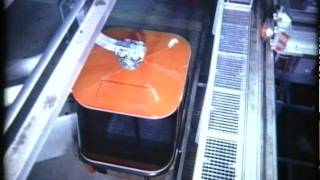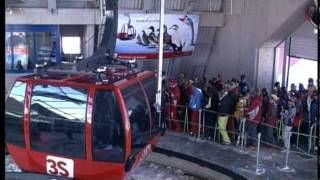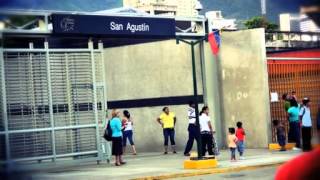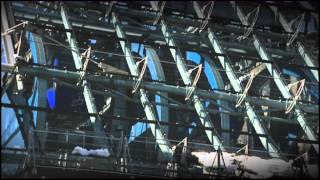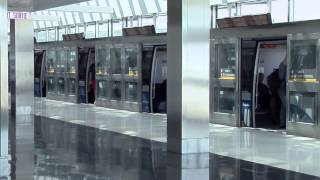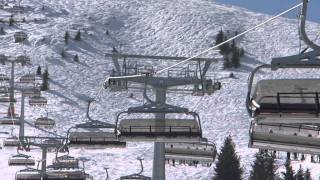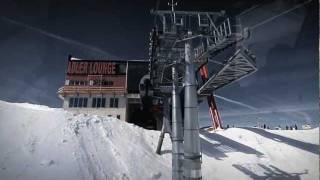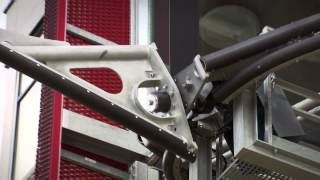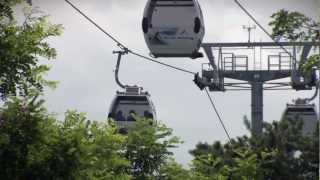Doppelmayr is heralding the next ropeway age with the TRI-Line. This innovative continuous-movement system combines the benefits of the proven D-Line with those of the high-capacity tricable (3S) system. Compact stations and ropeway components, spacious cabins for up to 20 people, a newly developed carriage, and a transport capacity of up to 8,000 passengers per hour and direction are the highlights of the TRI-Line. The first project is being built in Hoch-Ybrig in Switzerland.
The TRI-Line completely redefines what has been possible with ropeway technology up to now. It can be used for all applications – winter, summer and urban – and opens up new possibilities and new fields of application for sustainable, rope-propelled mobility. Its compact design ensures a small footprint and maximum efficiency.
The best of two worlds
“The TRI-Line is a detachable continuous-movement system and a compact further development based on two proven ropeway systems. It combines the benefits of the D-Line with those of the high-capacity 3S system,” explains Peter Luger, who heads development of the TRI-Line at Doppelmayr in Wolfurt. Its design is based on the D-Line and features a compact construction. In comparison with the substantially larger 3S installations, the stations take up considerably less space and have a significantly shorter construction time. The TRI-Line uses proven components from the D-Line – which means, for example, that the Doppelmayr Direct Drive can be used effectively on this new system. Another major feature of the TRI-Line is its high wind stability. This is ensured by the two track ropes, which provide a stable running surface, a haul rope, which moves the carriers, and the track rope supports. In addition, tubular towers are used on the TRI-Line. As well as reducing the space required, this brings advantages in the construction phase such as the suitability of the components for air transport and short installation times.
Comfort and high capacity
In terms of form and function, the cabin is seamlessly incorporated into the design line of the OMEGA V and the ATRIA. The modular seating concept is designed for all applications. It provides passengers with space and comfort for winter and all-year operations as well as for the urban environment. Up to 20 people can be carried in each cabin. Twelve people can enjoy the trip while seated on individual seats. In addition, the cabins are entirely barrier-free with level walk-in and exit and electrically operated doors on both sides. Having doors on both sides of the cabins means that passenger flows can be optimally organized in the stations – which offers a huge benefit for urban applications in particular. This enables the impressive transport capacity of up to 8,000 passengers per hour and direction – a new benchmark in the ropeway industry. Needless to say, autonomous ropeway operation with the AURO concept is also possible with the TRI-Line.
Carriage as technical highlight
The centerpiece of the TRI-Line development is based on a novel approach to the design of the carriage. Using the D-Line detachable grip is a key feature: “This has made it possible to create a very simple and maintenance-friendly construction. The individual components make for straightforward handling. Another advantage is the simple rope guidance in the stations. That enables us to use the compact D-Line stations and their components. From an engineering perspective, the carriage is an absolute highlight,” says Peter Luger.
First TRI-Line in Switzerland
The first TRI-Line worldwide is under construction in Hoch-Ybrig in Switzerland. It will replace a 55-year-old aerial tramway. In winter and summer, the region in Hoch-Ybrig attracts large numbers of visitors from Zurich and the surrounding areas for skiing or hiking. As an all-year destination, the region offers guests a broad spectrum of activities, which is why the ropeway and its availability play a key role. “With the TRI-Line, we’ve found a ropeway system that meets all our requirements – and does so for a reasonable price. While a monocable gondola would have been an option from a technical point of view, it would have entailed various challenges with our particular terrain and therefore been difficult to build. The 3S lift, as an alternative, was beyond our budget. The TRI-Line is compact and can cope with our wind conditions thanks to the 3S benefits, which is a decisive criterion for our important feeder lift. Thanks to the new cabins with their comfortable seats and the generously proportioned glazing, we can now offer our guests a far higher level of comfort,” says Urs Keller, CEO in Hoch-Ybrig.
Further details into the TRI-Line are to follow at Interalpin 2023.
Benefits at a glance:
- High capacity: The capacity of up to 8,000 passengers per hour and direction is unique in the ropeway industry.
- Compact: The TRI-Line is based on the D-Line. The compact stations and ropeway components make for a small footprint.
- Barrier-free: Cabin entry and exit are barrier-free. Having electrically operated doors on both sides opens up entirely new possibilities for passenger flow management.
- Digitalized: The TRI-Line is a connected ropeway system. All cabin functions can be integrated and controlled directly with the Doppelmayr Connect ropeway control system.
- Visionary: Autonomous ropeway operation is possible with the AURO concept.
In a special edition of Insights, TRI-Line development manager Peter Luger and Doppelmayr executive director Thomas Pichler present the new TRI-Line: insights.doppelmayr.com
Inquiries:
Doppelmayr Seilbahnen GmbH
Mag. Julia Schwärzler
PR Manager
Konrad-Doppelmayr-Straße 1, Postfach 20
6922 Wolfurt / Austria
Tel: +43 5574 604 227
Email: julia.schwaerzler@doppelmayr.com
Internet: doppelmayr.com







